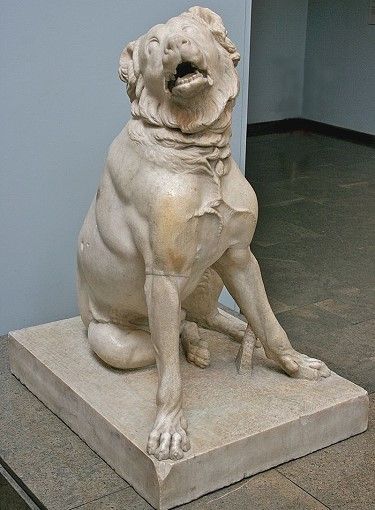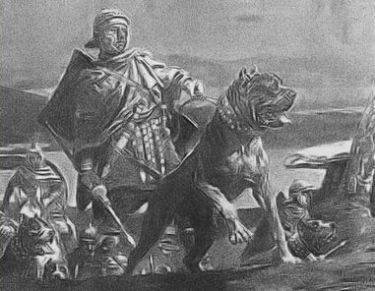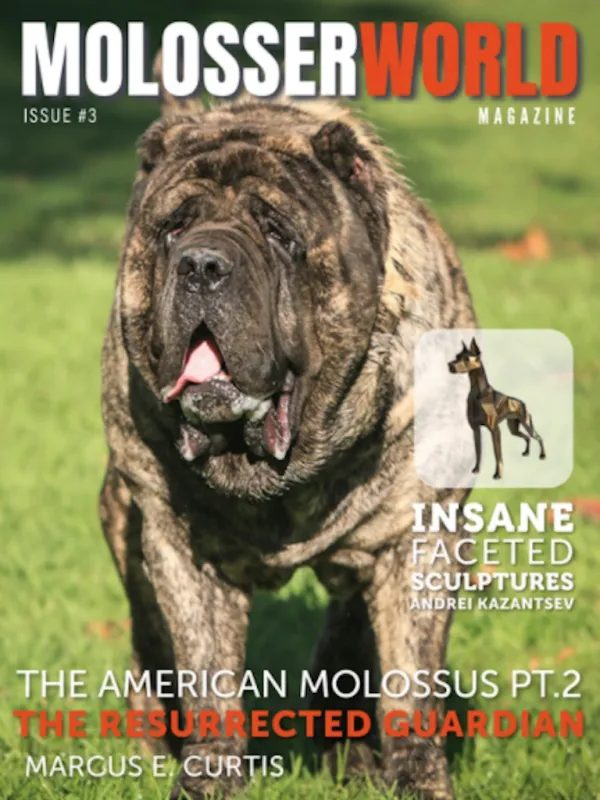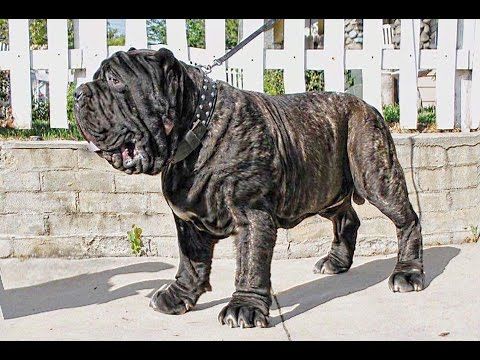The American Molossus is a new breed of dog that most people have never heard of. As big as a small lion, with the loyalty of a soldier, and cuddles like it’s a lap dog. If you’re envisioning a happy-faced behemoth, you’re not too far off.
The breed was created in hopes of resurrecting the legendary Molossus dog of antiquity. But is it really? Let’s take a look!
History of the American Molossus Dog
To fully understand the history behind this giant dog breed, we have to look at the old world molosser dogs it’s based on. Not just a few hundred years ago either; we’re talking 5000 years or more.

The Mesopotamian Molossus of Ancient Times
If you are into Greek or Roman history, you’ve likely heard about these ancient breeds before. But the truth is it stretches back much further than either of those civilizations.
The original Molossus was a dog that originated in Mesopotamia (modern-day Iraq), the cradle of all civilization. These dogs were bred by Assyrians and Babylonians as hunting and fighting dogs around 5000 BC. But they weren’t just large fighting dogs; they were also healers. Said to be dogs of the Gods, they were believed to have healing powers. More specifically that their saliva had the power to heal.
When Alexander the Great conquered Mesopotamia in the 4th century BC, he brought these dogs back to Greece. They quickly became favored by the ancient Greeks for their courage, loyalty, and fearlessness. Leading to them being used as livestock guardians, estate guardians, and later as war-dogs. They were so popular, in fact, that they were frequently mentioned in writings from famous philosophers and poets like:
- Aristophanes
- Aristotle
- Grattius
- Horace
- Lucan
- Lucretius
- Martial
- Nemesianus
- Oppian of Apamea
- Plautus
- Seneca
- Statius
- Ovil
- Virgil
When serious work has come, when bravery must be shown, and the impetuous War-god calls in the utmost hazard, then you could not admire the renowned Molossians so much
Grattius 8 AD
The breed itself got its name, Molossus, from Achilles’ grandson Molossus who founded the ancient Greek tribe known as Molossians.
Fast forward to the start of the Macedonian Wars in 214 BC when the Romans first encountered the Molossus dog. So impressed with the dogs’ skill and ferocity on the battlefield, the Romans brought some home, and they became the primary war dog of the Roman Legions.
Beyond their use in war, the Molossus was used as gladiator dogs, guard dogs, and personal protectors. They were also kept by emperors and nobles as pets and status symbols.
Extinction
Unfortunately, when the Roman empire fell, so did the Molossus. Many rumors exist as to why the breed was lost to history, but there are two that I think are most accurate. The first is that they were expensive to care for; at a time when the empire is crumbling, any extra expense would likely have been hard to come by. The second reason is that they were crossbred with other dogs, which created many new breeds, but the original was lost.
There are many dog breeds today that claim to be descendants of the molossus; some of them are:
- Mastiff
- Cane Corso
- Newfoundland
- Bernese Mountain Dog
- St. Bernard
- Great Pyrenees
- Rottweiler
- Great Danes
- Greater Swiss Mountain Dog
One thing all these dogs have in common is their fearless loyalty and guardian-type mentality. So it doesn’t seem very far-fetched to believe they are remnants of the ancient breed.

Modern Day
In modern times, it seems the ancient dog has returned. In 2017 in California, of all places (A far cry from Rome and Greece), Marcus Curtis realized his dream of bringing back the ancient Molossus, now named the American Molossus. Curtis spent years researching and investigating the long-lost dogs to create a breed as close as possible. He bred different dogs, like the Neapolitan Mastiff and English Mastiff, in pursuit of his goal.
Standing over 30 inches at the shoulder and weighing up to 200 pounds, Curtis claims his dogs are genetically and historically closer to the original Molossus than any other existing breed. The exact appearance and characteristics of the original are unknown since there are no records or images of them. The only clues we have come from ancient writings or sculptures that depict the dog breed. Still, Curtis says his dogs have inherited the ancient qualities of courage, loyalty, and protection from their ancestors.
Currently, the American Molossus is recognized by the American Dog Federation, US Bully Registry, Designer Breed Registry, and the American Rare Breed Association.

The Appearance of the American Molossus
The American Molossus is a giant dog that resembles a mastiff-like appearance. They have large heads with broad muzzles, droopy lips, and wrinkles on their face and necks. They have smaller ears that can be cropped and dark eyes that express intelligence and alertness. Their body is heavily muscled with a deep chest, thick neck, long tail, and powerful legs.
An American Molossus is truly a sight to behold; they can reach up to 250 lbs and 40 inches in height. A dog at this size is larger than the breed standard, but it does happen. The creator of the breed, Curtis, says his goal is not to produce the biggest dogs in the world but to focus on quality and health to produce a functional dog that can perform its duty as a guardian. Even still, the American Molossus is certainly among the biggest dogs in the world.
Coat Type and Colors
According to the breed standard, the American Molossus has a short-medium coat that is coarse and dense. Acceptable colors are black, black-brindle, and brindle. White is allowed in certain areas but not preferred.
The Personality of the American Molossus
One of the main purposes of the American Molossus is to be a loyal and protective guardian that bonds strongly with its owner and family. They are gentle giants that are affectionate toward loved ones but, by nature, are wary and suspicious of strangers. They have an instinctual need to guard their home and will confront any threat. They also love to play and will often try to cuddle with their family members. The keyword being “try” because they are definitely not lap dogs, although they probably think they are.
American Molossus dogs are not active dogs, but they still need regular exercise to stay healthy. Whether that’s in the form of walks or playing doesn’t matter to them.
They can adapt to many different climates but tend to prefer cooler weather.
A big dog also needs big space. They need space to move around, roam and explore, and enjoy life. With that in mind, they are not a good breed for apartment living.
American Molossus dogs need an experienced owner that can be firm and consistent with their leadership. They also need to be socialized at an early age to different people, animals, and situations. Doing so will help prevent unwanted aggression and fearfulness.
Where the country mouse has his fill of the city when the house resounds with the barking of Molossians
Horace Satires, VI
The Health of the American Molossus
As man’s best friend, we want our dogs to be in our lives as long as possible. Fortunately, the American Molossus breed is pretty healthy compared to other giant dog breeds. Curtis claims that he has eliminated many of the common health issues that affect mastiffs, such as hip dysplasia, bloat, eye problems, skin infections, and cancer. He also says that his dogs have longer lifespans than most giant breeds, averaging 10 to 12 years.
This does not, however, mean that the American Molossus will be immune to disease or disorders. More likely that the breed has less of a chance to inherit or suffer from the health problems listed above. Like any dog, they may still need veterinary attention at some point. A few things to watch out for in breeds like this are:
- Elbow dysplasia: A condition where the elbow joint does not develop properly, causing pain and lameness.
- Hypothyroidism: A condition where the thyroid gland does not produce enough hormones, causing weight gain, lethargy, hair loss, and skin problems.
- Heart disease: A condition where the heart does not function properly, causing breathing difficulties, weakness, and fainting.
- Ectropion: A condition where the lower eyelid droops outward, exposing the eye to irritation and infection.
- Entropion: A condition where the upper eyelid rolls inward, causing the eyelashes to rub against the eye and cause damage.
- Cherry eye: A condition where the third eyelid protrudes from the corner of the eye, causing inflammation and infection.
- Cystinuria: A condition where the urine contains high levels of cystine, a type of amino acid, causing kidney stones and urinary blockage.
To prevent or minimize the chance of these conditions, feed your dog a healthy diet, get routine check-ups, and be mindful of changes in their appearance or actions.
Caring for an American Molossus
The American Molossus is a low-maintenance breed when it comes to grooming. The shorter coat only needs occasional brushing to remove dead hair and dirt. They may need occasional bathing, especially if they get dirty or smelly.
If you are looking for a hypoallergenic dog, the American Molossus is not it. They shed year-round and drool a lot. Both of which affect people with dog allergies. Owners also need to be prepared to wipe its mouth and face to keep it clean.
There are no specific dietary needs for an American Molossus. They need high-quality food, and the amount will vary by size, age, and activity level. If you have any dietary questions you should ask the veterinarian that regularly sees your dog.
While they don’t need a lot of exercise, they do need physical and mental stimulation. American Molossus’ are intelligent dogs that are prone to boredom which can lead to destructive behavior. The best thing to do is play with them or provide training sessions. When that’s not an option toys, games, and puzzles can be a great alternative.
The Pros and Cons of the American Molossus
All dog breeds have advantages and disadvantages. Some of the pros and cons of owning an American Molossus are:
Pros
- Loyal and Protective.
- Gentle and affectionate with its loved ones.
- Healthy compared to other giant breeds.
- Low-maintenance.
- Rare and Unique breed.
Cons
- Aggressive or fearful if not socialized properly.
- Needs a lot of space and training.
- Expensive
- Not hypoallergenic
- Drools… A lot.
Good with Children and Other Pets
Before deciding to bring an American Molossus into your household, there are several factors that should be taken into account. This breed is known for being affectionate and well-behaved around children, making them great companions for families. But, it is important to note that they are more suitable for older children.
Although it’s unlikely for them to show aggression towards children, their large size and tendency to be a bit clumsy can accidentally harm younger or smaller kids.
While all dogs require proper introductions, the American Molossus generally gets along well with other dogs in the family. However, it’s recommended to introduce them when young to smaller pets, such as cats or hamsters, as their hunting instincts could pose a threat.
While they often act reserved towards strangers, this breed is typically laid-back and easy to get along with for everyone in the household.
























